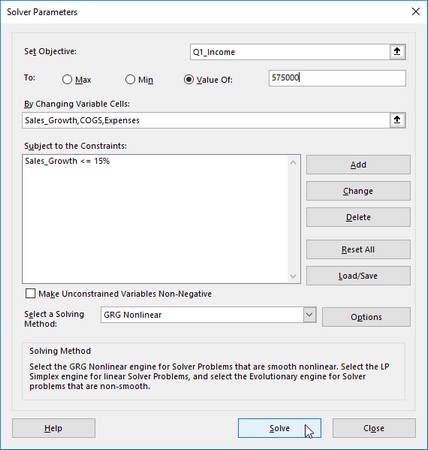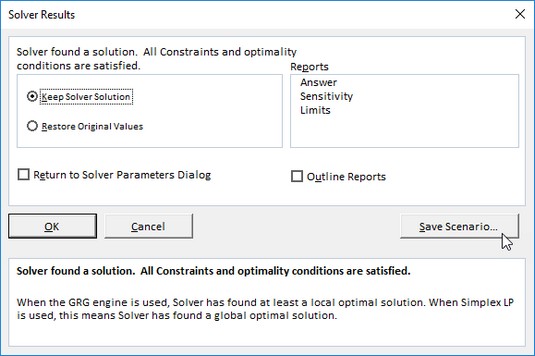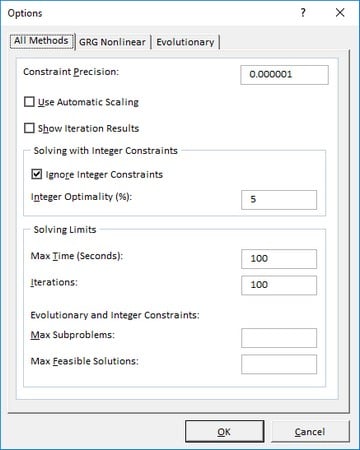How To Use Excel Solver On Mac
The Solver add together-in works by applying iterative methods to find the "best" solution given the inputs, desired solution, and the constraints that yous impose. With each iteration, the program applies a trial-and-error method (based on the utilize of linear or nonlinear equations and inequalities) that attempts to get closer to the optimum solution.
When using the Solver add-in, keep in heed that many problems, particularly the more than complicated ones, have many solutions. Although the Solver returns the optimum solution, given the starting values, the variables that tin change, and the constraints that you define, this solution is often not the only one possible and, in fact, may not be the best solution for you lot. To be certain that you are finding the best solution, you may desire to run the Solver more than in one case, adjusting the initial values each time yous solve the problem.
When setting upward the trouble for the Solver add-in in your Excel worksheet, define the following items:
- Objective cell: The target cell in your worksheet whose value is to be maximized, minimized, or made to reach a detail value. Note that this prison cell must incorporate a formula.
- Variable cells: The changing cells in your worksheet whose values are to exist adjusted until the answer is plant.
- Constraint cells: The cells that contain the limits that y'all impose on the irresolute values in the variable cells and/or the target cell in the objective cell.
You lot can use the Solver add together-in with the Scenario Director to help ready a trouble to solve or to save a solution and so that you tin can view it at a later on date. The changing cells that you define for the Scenario Managing director are automatically picked up and used by the Solver when yous select this command, and vice versa. Also, you can save the Solver'south solution to a problem every bit a scenario (past clicking the Save Scenario push in the Solver dialog box) that you lot can and so view with the Scenario Director.
Setting upwardly and defining the problem in Excel 2019
The first step in setting up a trouble for the Solver to work on is to create the worksheet model for which you volition define the objective cell, variables cells, and the constraint cells.Keep in mind that the Solver is an add-in utility. This means that, before you lot can use it, you need to make sure that the Solver add together-in program is even so loaded, equally indicated by the appearance of the Solver button in the Analysis grouping at the terminate of the Data tab on the Ribbon. If this button is missing, you lot can load Solver by opening the Add-Ins tab of the Excel Options dialog box (Alt+FTAA) and then clicking the Become push button after making sure that Excel Add-Ins is displayed in the Manage drop-down list box to its immediate left. And then, select the Solver Add together-in check box in the Add-Ins dialog box to put a check marker in it before you click OK to close the dialog box and reload the add-in.
To define and solve a problem with the Solver add-in later you lot've loaded the add-in and have created your worksheet model, you lot follow these steps:
- Click the Solver command button in the Analyze group at the finish of the Ribbon'southward Data tab.
Excel opens the Solver Parameters dialog box.
 Specifying the parameters to apply to the model in the Solver Parameters dialog box.
Specifying the parameters to apply to the model in the Solver Parameters dialog box. - Click the target cell in the worksheet or enter its cell reference or range proper noun in the Gear up Objective text box.
Next, you need to select the To setting. Click the Max choice push button when you lot want the target cell's value to be equally large as possible. Click the Min option push when you lot desire the target cell'southward value to be equally pocket-size as possible. Click the Value Of option button and so enter a value in the associated text box when you lot want the target cell'south value to attain a particular value.
- Click the appropriate option push button option in the To section of the dialog box. If yous select the Value Of option button, enter the value to match in the associated text box.
Next, designate the variable cells — that is, the ones Solver can alter to reach your Equal To goal.
- Click the By Changing Variable Cells text box and and then select the cells to alter in the worksheet or enter their cell references or range name in the text box.
Retrieve that to select nonadjacent cells in the worksheet, yous need to hold down the Ctrl key every bit you click each prison cell in the selection. To have Excel cull the changing cells for yous based on the target cell that you selected, click the Estimate push button to the correct of this text box.
Before having Solver adjust your model, you may add constraints for the target cell or whatever of the changing cells that determine its limits when adjusting the values.
- (Optional) Click the Add button to the right of the Bailiwick to the Constraints list box in the Solver Parameters dialog box.
This action opens the Add Constraint dialog box. When defining a constraint, choose the cell whose value you desire to constrain or select the cell in the worksheet or enter its cell reference in the Cell Reference text box. Then select the relationship (=, <=, >=, or int for integer or bin for binary) from the drop-down list box to the right and (unless you chose int or bin) enter the advisable value or prison cell reference in the Constraint text box.
To continue adding constraints for other cells used by the Solver, click the Add push button to add together the constraint and clear the text boxes in the Add Constraint dialog box. So, repeat Stride v to add a new constraint. After y'all cease defining constraints for the target jail cell and changing values in the model, click OK to shut the Add together Constraint dialog box and return to the Solver Parameters dialog box (which now lists your constraints in the Subject to the Constraints listing box).
- (Optional) Deselect the Make Unconstrained Variables Non-Negative bank check box if you want to allow negative values when the variable cells are not bailiwick to constraints.
By default, the Solver Add-in employs the GRG (Generalized Reduced Slope) Nonlinear method in solving the model whose parameters yous're setting known as a very efficient way to solve smooth nonlinear problems. To use the LP Simplex method (for Linear Programming post-obit the Simplex algorithm) or Evolutionary engine for solving non-smoothen problems, you need to follow Step 7.
- (Optional) Select LP Simplex or Evolutionary from the Select a Solving Method drop-downwardly list to employ either one of these methods solving nonsmooth problems.
- Click the Solve push to have the Solver solve the problem equally you've defined it in the Solver Parameters dialog box.
Solving the problem with Excel's Solver
When you click the Solve button, the Solver Parameters dialog box disappears, and the status bar indicates that the Solver is setting up the trouble then keeps you lot informed of the progress in solving the trouble by showing the number of the intermediate (or trial) solutions every bit they are tried. To interrupt the solution procedure at any time before Excel calculates the last iteration, press the Esc key. Excel so displays the Show Trial Solution dialog box, informing y'all that the solution process has been paused. To go along the solution process, click the Continue button. To abort the solution process, click the Cease button.When Excel finishes the solution process, the Solver Results dialog box appears. This dialog box informs you whether the Solver was able to discover a solution, given the target cell, irresolute cells, and constraints divers for the problem. To retain the changes that the Solver makes in your worksheet model, leave the Keep Solver Solution option push selected and click OK to close the Solver Results dialog box. To return the original values to the worksheet, click the Restore Original Values pick button instead. To salvage the changes as a scenario before you restore the original values, click the Salvage Scenario button and assign a name to the current scenario before yous click the Restore Original Values selection and OK button.
 The Solver Results dialog box showing that Solver found a solution to the problem.
The Solver Results dialog box showing that Solver found a solution to the problem.
Dissimilar when using the Goal Seek command, after clicking the Keep Solver Solution selection button in the Solver Results dialog box, you lot tin can't employ the Undo control button on the Quick Access toolbar to restore the original values to your worksheet. If yous want to be able to switch between the "before" and "afterwards" views of your worksheet, you must salve the changes with the Save Scenario button and and so select the Restore Original Values option button. That way, you lot tin can retain the "before" view in the original worksheet and utilize the Scenario Manager to display the "after" view created by the Solver.
Changing Excel's Solver options
For well-nigh of the problems, the default options used by the Solver are adequate. In some situations, withal, yous may want to modify some of the Solver options earlier yous begin the solution process. To change the solution options, click the Options push in the Solver Parameters dialog box. Excel then opens the Options dialog box with the All Methods tab selected where yous can make all necessary changes.  Modifying the solution options in the Options dialog box.
Modifying the solution options in the Options dialog box.
| Selection | Role |
| Constraint Precision | Specifies the precision of the constraints. The number that yous enter in this text box determines whether the value in a constraint cell meets the specified value or the upper or lower limit y'all take gear up. Specify a lower number (between 0 and 1) to reduce the time it takes the Solver to render a solution to your problem. |
| Use Automated Scaling | Select this cheque box to have the Solver automatically scale the results when solving the problem. |
| Show Iteration Results | Select this cheque box to have the Solver show the results for the iterations followed in solving the trouble. |
| Ignore Integer Constraints | Select this check box to have the Solver ignore whatever constraints you specify that use integers. |
| Integer Optimality (%) | Specifies the percentage of integer optimality criteria that the Solver applies in solving the problem. |
| Max Time (seconds) | Specifies the maximum number of seconds that the Solver will spend on finding the solution. |
| Iterations | Specifies the maximum number of times that the Solver will recalculate the worksheet when finding the solution. |
| Max Subproblems | Specifies the maximum number of subproblems that the Solver takes on when using the Evolutionary method to solve the problem. |
| Max Feasible Solutions | Specifies the maximum number of viable solutions that the Solver will pursue when y'all select the Evolutionary method for solving the problem. |
When you use the default GRG (Generalized Reduced Gradient) Nonlinear or Evolutionary method, yous can gear up additional Solver settings using the options on the GRG Nonlinear and Evolutionary tabs of the Options dialog box. These options include changing the Converge, Population Size, and Random Seed settings for either of these particular methods.
Saving and loading a model problem in Excel 2019
The objective cell, variable cells, constraint cells, and Solver options that you most recently used are saved as part of the Excel worksheet when you click the Relieve button on the Quick Access toolbar (Ctrl+S). When yous ascertain other bug for the same worksheet that y'all desire to salve, yous must click the Save Model button in the Solver Options dialog box and indicate the cell reference or name of the range in the active worksheet where you desire the problem'southward parameters to be inserted.When y'all click the Load/Save button, Excel opens the Load/Salve Model dialog box, containing a Select Model Area text box. This text box contains the prison cell references for a range large enough to hold all the problem's parameters, starting with the agile jail cell. To save the problem's parameters in this range, click OK. If this range includes cells with existing data, you demand to modify the cell reference in this text box before you lot click OK to forestall Excel from replacing the existing data.
Subsequently you click OK, Excel copies the problem's parameters in the specified range. These values are then saved as function of the worksheet the next fourth dimension you salve the workbook. To reuse these problem parameters when solving a problem, you simply need to open the Solver Options dialog box, click the Load/Save push to open the Load/Salve Model dialog box, click the Load button, and then select the range containing the saved problem parameters. When you click OK in the Load Model dialog box, Excel loads the parameters from this jail cell range into the appropriate text boxes in the Solver Parameters dialog box. You can and so close the Solver Options dialog box by clicking OK, and y'all tin solve the trouble by using these parameters by clicking the Solve command button.
Call up that you can use the Reset All button whenever you want to articulate all the parameters divers for the previous problem and return the Solver options to their defaults.
Creating Solver reports in Excel 2019
Y'all can create three dissimilar types of reports with the Solver:- Reply report: Lists the target cell and irresolute cells with their original and final values, forth with the constraints used in solving the problem.
- Sensitivity report: Indicates how sensitive an optimal solution is to changes in the formulas that summate the target cell and constraints. The written report shows the irresolute cells with their final values and the reduced gradient for each jail cell. (The reduced slope measures the objective per unit of measurement increase in the changing cell.) If you defined constraints, the Sensitivity report lists them with their final values and the Lagrange multiplier for each constraint. (The Lagrange multiplier measures the objective per unit increase that appears in the correct side of the constraint equation.)
- Limits report: Shows the target jail cell and the changing cells with their values, lower and upper limits, and target results. The lower limit represents the lowest value that a changing prison cell tin accept while fixing the values of all other cells and nonetheless satisfying the constraints. The upper limit represents the highest value that will do this.
When yous click OK to close the Solver Results dialog box (after choosing between the Go along Solver Solution and Restore Original Values options), Excel generates the report (or reports) that you selected in a new worksheet that it adds to the beginning of the workbook. (Written report sheet tabs are named by report blazon, as in Answer Report 1, Sensitivity Report ane, and Limits Report 1.)
How To Use Excel Solver On Mac,
Source: https://www.dummies.com/article/technology/software/microsoft-products/excel/how-to-use-the-excel-2019-solver-259741/
Posted by: haydenconevenibary.blogspot.com


0 Response to "How To Use Excel Solver On Mac"
Post a Comment